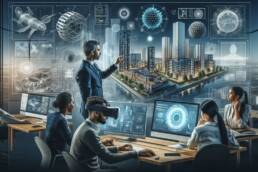The e-commerce landscape is being transformed by the advent of high-quality product rendering, offering businesses new ways to engage consumers and enhance their online shopping experience. This article delves into the various aspects of product rendering, from its impact on consumer behavior to the technological advancements that make it possible, strategic marketing implementations, cost-benefit analysis, and future trends. We will explore how product rendering not only revolutionizes the presentation of products but also serves as a powerful tool for companies to stand out in a crowded digital marketplace.
Key Takeaways
- High-quality product rendering significantly influences consumer behavior by enhancing the online shopping experience and facilitating informed purchasing decisions.
- Technological advancements, including the evolution of rendering software and the integration of AI, have elevated the capabilities of 3D visualization in e-commerce.
- Strategic implementation of product rendering in marketing can optimize visual content for e-commerce platforms and improve consumer engagement.
- A cost-benefit analysis reveals that product rendering can be more cost-effective than traditional photography, offering long-term savings and scalability.
- Future trends in product rendering are likely to include shifts in consumer expectations and the emergence of new technologies that will continue to shape product visualization.
The Impact of High-Quality Product Rendering on Consumer Behavior

1. Enhancing Online Shopping Experience
In our quest to revolutionize e-commerce, we recognize the pivotal role of high-quality product rendering in enhancing the online shopping experience. Visual fidelity is paramount; it bridges the gap between digital storefronts and the tactile reality of in-store shopping. By presenting products with stunning realism, we empower customers to explore and appreciate the fine details as if the product were in their hands.
Customer engagement increases significantly when shoppers can interact with a product through features like zoom, rotation, and color changes. This interactive element not only entertains but also educates, leading to a more confident purchase decision. Here’s how high-quality rendering impacts the shopping experience:
- Provides a rich, immersive visual context.
- Allows for detailed inspection of product features.
- Encourages longer site engagement times.
- Reduces the uncertainty associated with online purchases.
By integrating advanced rendering technologies, we facilitate a seamless and enjoyable shopping journey, setting a new standard for online retail.
As we continue to innovate, our commitment to delivering an unparalleled online shopping experience remains steadfast. We invite you to explore the transformative potential of high-quality product rendering and join us in shaping the future of e-commerce.
2. Facilitating Informed Purchasing Decisions
In the realm of e-commerce, we understand the pivotal role that high-quality product rendering plays in facilitating informed purchasing decisions. Visual clarity and detail are paramount in conveying the true essence of a product, allowing consumers to closely examine features and quality without the tactile feedback of a physical store. This transparency builds trust and confidence in the online shopping environment.
Interactive 3D visuals and detailed product specifications provide a comprehensive understanding of the product, which is crucial for customers who rely on online information to make their purchasing choices. By presenting products in a variety of contexts and from multiple angles, we empower customers to make decisions that align with their expectations and needs.
Our commitment to excellence in product rendering ensures that every visual detail is meticulously crafted to enhance the customer’s decision-making process.
The following list highlights the benefits of high-quality product rendering in e-commerce:
- Detailed visualization of product features
- Reduction of ambiguity and potential for returns
- Increased customer satisfaction and loyalty
- Enhanced ability to compare products effectively.
We strive to revolutionize the e-commerce landscape by providing visuals that not only captivate but also inform and reassure our customers. As we continue to innovate, our focus remains steadfast on delivering renderings that serve as a cornerstone for informed purchasing decisions.
3. Influencing Perceived Product Value
In the realm of e-commerce, the perceived value of a product can be significantly influenced by the quality of its visual representation. High-quality product rendering not only showcases the product in the best possible light but also imbues it with a sense of higher worth. This psychological impact on consumers can be the deciding factor in their purchase decisions.
3D product renderings serve a multitude of purposes across various stages of product development, marketing, and sales, proving to be invaluable assets for enhancing the perceived value. Here are some ways in which product rendering elevates perceived value:
- By providing a detailed and accurate visual representation, customers can appreciate the craftsmanship and quality of the product.
- Renderings can highlight features and benefits that may not be immediately apparent in traditional photography.
- The ability to visualize products in different environments and from multiple angles can create a more engaging and immersive experience.
The strategic use of product rendering in marketing campaigns can effectively communicate the value proposition of a product, making it more desirable to potential buyers.
As we continue to explore the potential of product rendering, it is clear that its role in shaping consumer perception is both powerful and indispensable. By investing in advanced rendering techniques, businesses can not only enhance the appeal of their products but also build a stronger brand image that resonates with quality and innovation.
The Impact of High-Quality Product Rendering on Consumer Behavior

1. Evolution of Rendering Software
As we delve into the realm of e-commerce, we recognize the pivotal role that the evolution of rendering software plays in revolutionizing the industry. The journey from rudimentary graphics to today’s sophisticated, photorealistic visualizations marks a significant leap in how we present products online. High-quality product rendering has become a cornerstone of digital marketing, offering a lifelike representation that captivates consumers and enhances their shopping experience.
Our expertise in the latest rendering technologies enables us to create immersive visuals that not only attract but also retain customer attention. The table below highlights the transformative stages of rendering software:
| Generation | Characteristics | Impact on E-commerce |
|---|---|---|
| Early 2D | Basic shapes and colors | Limited engagement |
| 3D Graphics | Improved depth and realism | Enhanced product understanding |
| Photorealism | Lifelike textures and lighting | High emotional connection |
| Real-time 3D | Instant rendering and interactivity | Interactive shopping experiences |
By harnessing the power of advanced rendering software, we are able to offer a seamless and interactive shopping journey, setting a new standard in online consumer engagement.
We invite you to explore the possibilities that these technological advancements can bring to your e-commerce platform. Embrace the future of digital retail with us, where every pixel is a step towards a more engaging and successful online presence.
2. Integration of AI in Product Visualization
At the forefront of e-commerce innovation, we find the integration of artificial intelligence (AI) in product visualization, a transformative force in the digital marketplace. AI-driven rendering tools are now capable of generating high-quality images that rival traditional photography, offering a cost-effective and scalable solution for online retailers. The strategic use of AI in rendering not only enhances the visual quality but also streamlines the production process.
The benefits of AI in product visualization are manifold:
- Automated background generation enhances the efficiency of creating product images, allowing for rapid adaptation to different visual contexts.
- AI algorithms can produce photorealistic images of space and planets, showcasing the potential for highly detailed and imaginative visuals.
- The integration of AI facilitates real-time rendering and interactive visuals, providing customers with an immersive shopping experience.
By leveraging AI, businesses can achieve a significant reduction in the time and resources required to generate captivating product visuals, ultimately leading to increased consumer engagement and sales.
We encourage our readers to explore the possibilities that AI-enhanced product rendering offers. It’s not just about keeping up with current trends; it’s about staying ahead and revolutionizing the way we present products in the digital realm. The future of e-commerce is visual, and AI is the key to unlocking its full potential.
3. Real-time Rendering and Interactive Visuals
In the dynamic world of e-commerce, the ability to present products in the most appealing and accurate way possible is crucial. Real-time rendering and interactive visuals have emerged as game-changers, offering customers an unparalleled online shopping experience. By leveraging the latest advancements in real-time rendering, we enable instant visualization and interactivity that captivate consumers and encourage engagement.
Our AI-driven, 3D product visualizations create interactive shopping experiences that provide the necessary details for a customer to make an informed purchase.
This technology not only enhances the visual appeal but also empowers customers to explore products from every angle, leading to more confident purchasing decisions. Here’s how real-time rendering is transforming the e-commerce landscape:
- Instantly generated images that adapt to user interactions
- Seamless integration of products into realistic environments
- Dynamic customization options that reflect changes in real-time
The strategic use of real-time rendering can significantly influence consumer behavior, leading to increased satisfaction and loyalty. As we continue to innovate, the potential for even more immersive and interactive e-commerce experiences is limitless.
Strategic Implementation of Product Rendering in Marketing
1. Optimizing Visual Content for E-commerce Platforms
In our collective journey to revolutionize e-commerce, we recognize the pivotal role of high-quality product rendering in enhancing the online shopping experience. We’ll cover the best strategies for e-commerce marketing by creating visual content that helps your brand and products stand out. By optimizing visual content for e-commerce platforms, we ensure that each product is showcased in the most compelling way possible.
Visual optimization is not just about aesthetics; it’s a strategic move to increase engagement and conversion rates. Here’s how we approach it:
- Consistency Across Platforms: Maintain a uniform look and feel for your product images across all online touchpoints.
- SEO-Driven Visuals: Use relevant keywords in file names, alt texts, and captions to improve search engine visibility.
- Interactive Elements: Incorporate 360-degree views and zoom-in features to allow customers a closer look.
- Mobile Optimization: Ensure visuals are responsive and adapt seamlessly to various screen sizes.
By meticulously curating and rendering visuals, we facilitate informed purchasing decisions and influence the perceived value of products.
The strategic implementation of product rendering not only captivates the consumer but also serves as a cornerstone for building a robust online presence. Let’s get started on transforming your e-commerce platform with visuals that resonate with your audience and drive results.
2. Leveraging Rendering for Cross-Platform Marketing Campaigns
In our quest to revolutionize e-commerce, we recognize the power of high-quality product rendering as a cornerstone in cross-platform marketing campaigns. Integrating renderings in e-commerce platforms enhances customer engagement, brand perception, trust, and loyalty. We advocate for a strategic approach that encompasses various digital touchpoints, ensuring a consistent and compelling visual narrative across all channels.
Product rendering serves as a dynamic tool, allowing us to create versatile marketing assets that can be adapted for social media, email marketing, and beyond. This adaptability not only streamlines the creative process but also ensures that our marketing efforts resonate with a diverse audience. By doing so, we foster a cohesive brand identity that captivates and retains consumer attention.
We must invest in technical infrastructure for seamless user experience and prioritize collaboration in 3D visualization for product development.
To illustrate the effectiveness of rendering in marketing, consider the following points:
- Rendered visuals can be repurposed for various campaign elements, from online banners to interactive displays.
- High-quality renders evoke a premium feel, elevating the perceived value of products.
- Real-time rendering technologies enable personalized and immersive shopping experiences.
By embracing these practices, we not only enhance the aesthetic appeal of our products but also empower consumers to make informed decisions, thereby driving sales and fostering brand loyalty.
3. Analyzing Consumer Engagement with Rendered Images
In our quest to revolutionize e-commerce, we recognize the pivotal role of consumer engagement in the success of high-quality product rendering. Engagement metrics serve as a compass, guiding us to understand how consumers interact with rendered images. By meticulously analyzing these metrics, we can tailor visual content to resonate more deeply with our audience.
Consumer reviews and feedback are invaluable in gauging the effectiveness of product renderings. Positive testimonials, like those received by CG VIZ Studio, reflect not only satisfaction but also the potential of rendered images to convert interest into sales. Here’s a snapshot of the impact:
- Enhanced product understanding through detailed visuals.
- Increased time spent on product pages.
- Higher click-through rates for marketing campaigns
- Improved conversion rates
By leveraging data-driven insights, we can refine our rendering strategies to align with consumer preferences, ultimately driving better e-commerce performance.
Investing in advanced rendering technologies is not just about aesthetics; it’s about building a bridge between products and consumers. As we continue to innovate, the strategic implementation of product rendering will remain a cornerstone of our marketing efforts. We invite you to explore the transformative power of rendering and join us in shaping the future of e-commerce.
Cost-Benefit Analysis of Product Rendering Versus Traditional Photography
1. Comparative Analysis of Expenses
When we consider the financial implications of product visualization, it’s essential to recognize the stark contrast between traditional photography and modern 3D product rendering. Traditional photography can be a costly endeavor — from the logistics of transporting products to the expenses of hiring a professional photographer and renting studio space. In contrast, 3D rendering is a one-time investment that can yield an array of versatile images without the recurring costs associated with physical photoshoots.
The shift towards digital rendering not only streamlines the production of marketing materials but also offers a cost-effective solution for businesses looking to enhance their e-commerce presence.
To illustrate the cost differences, let’s examine a simplified expense comparison:
| Expense Category | Traditional Photography | 3D Rendering |
|---|---|---|
| Studio Rental | High | None |
| Equipment | High | None |
| Staffing | Variable | None |
| Post-Production | High | Included |
This table underscores the potential for significant savings when opting for digital rendering over traditional photography. By embracing 3D visualization, companies can allocate their resources more efficiently, ensuring a better return on investment while maintaining high-quality visual content.
2. Assessing the ROI on Rendering Investments
In our quest to revolutionize e-commerce through high-quality product rendering, we meticulously assess the return on investment (ROI) to ensure that the benefits outweigh the costs. The strategic shift from traditional photography to advanced rendering techniques is not just a creative decision, but a financially sound one. By eliminating the need for physical prototypes and photo shoots, rendering services significantly reduce expenses, particularly for businesses with extensive product lines or those requiring frequent updates.
Cost-effectiveness is a hallmark of product rendering, but the true measure of ROI extends beyond initial savings. We consider the enhanced marketability of products, the ability to facilitate rapid prototyping, and the agility to respond to market trends. The following table encapsulates the comparative ROI metrics:
| Aspect | Traditional Photography | Product Rendering |
|---|---|---|
| Cost | High | Low |
| Flexibility | Limited | High |
| Time to Market | Slower | Faster |
| Scalability | Challenging | Effortless |
By integrating product rendering into our marketing strategies, we not only achieve a reduction in costs but also gain a competitive edge through dynamic and interactive visuals that captivate consumers.
To fully capitalize on the advantages of product rendering, we continuously analyze consumer engagement and refine our visual content. This iterative process ensures that our e-commerce platforms remain at the forefront of innovation, driving both customer satisfaction and business growth.
3. Long-term Savings and Scalability
When we consider the long-term implications of product rendering, the benefits become even more pronounced. The scalability of digital rendering is a game-changer for businesses looking to expand their product lines without incurring exponential costs. Unlike traditional photography, which requires new setups and shoots for each product variation, rendering allows for swift adjustments at a fraction of the cost. This flexibility is not just a matter of convenience; it’s a strategic advantage in a market that demands rapid response to consumer trends.
The integration of AI-powered rendering and cloud-based solutions has further enhanced the cost-effectiveness of product visualization. These technologies streamline the rendering process, reducing the time and resources needed to generate high-quality images.
Moreover, the environmental sustainability of rendering cannot be overlooked. By eliminating the need for physical prototypes and reducing waste, digital rendering aligns with the growing consumer demand for eco-friendly practices. Here’s a snapshot of the long-term benefits:
- Significant reduction in the need for physical prototypes
- Customization and updates executed with minimal additional expense.
- Lower carbon footprint compared to traditional photography.
Future Trends and Innovations in Product Rendering
1. Predicting Shifts in Consumer Expectations
As we navigate the ever-evolving landscape of e-commerce, we recognize the pivotal role that high-quality product rendering plays in shaping the future of online shopping. Consumer expectations are shifting towards more immersive and interactive experiences, demanding a higher level of detail and realism in online product presentations. To stay ahead, we must anticipate these changes and integrate advanced rendering techniques that cater to these preferences.
Integrating 3D renderings into online shopping platforms enhances product visualization, providing customers with a realistic and immersive experience. This not only satisfies the current demand for high-quality visuals but also sets the stage for future innovations in e-commerce. We’ve identified several key areas where consumer expectations are likely to evolve:
- Demand for ultra-realistic product visuals that blur the line between digital and physical.
- Expectation of interactive and customizable product experiences
- Increased preference for virtual try-on features and augmented reality integrations
By proactively adapting to these trends, we position ourselves at the forefront of the industry, ensuring that our clients’ products are not just seen but experienced in a way that resonates with modern consumers.
To effectively meet these emerging needs, we must embrace new technologies and continuously refine our rendering capabilities. The future of online shopping hinges on our ability to deliver renderings that not only captivate but also convert.
2. Emerging Technologies Shaping Product Visualization
As we navigate the ever-evolving landscape of e-commerce, emerging technologies are playing a pivotal role in shaping the future of product visualization. At the forefront, real-time rendering is revolutionizing the way consumers interact with products online, offering an immersive experience that was once unimaginable. The integration of virtual and augmented reality (VR and AR) is blurring the lines between digital and physical realms, providing a new dimension to online shopping.
The synergy between advanced rendering techniques and VR/AR platforms is creating unparalleled opportunities for product engagement and customer satisfaction.
Furthermore, the adoption of AI in rendering processes is not only enhancing the quality of visuals but also streamlining the workflow, making it more efficient and cost-effective. Here’s a glimpse into how these technologies is transforming the industry:
- Real-time Rendering: Instant visualization and interactivity, enhancing the customer journey.
- AI Integration: Automated and intelligent optimization of rendering tasks.
- VR and AR: Immersive experiences that elevate the standard of online product presentation.
We, as industry experts, recognize the importance of staying ahead of the curve. By harnessing these technologies, businesses can unlock new growth avenues and cater to the sophisticated demands of modern consumers. It’s an exciting time for e-commerce, and we are committed to exploring these frontiers to deliver cutting-edge solutions to our clients.
3. Sustainable Practices in Digital Rendering
In our quest to revolutionize e-commerce with high-quality product rendering, we recognize the importance of sustainability in our operations. As the digital realm expands, so does our responsibility to employ environmentally conscious practices. We are committed to reducing our carbon footprint by optimizing rendering processes and utilizing energy-efficient technologies.
Cloud-based rendering solutions have emerged as a game-changer, offering scalable resources that eliminate the need for energy-intensive local hardware. This approach not only democratizes high-performance rendering capabilities but also aligns with our sustainable objectives. By leveraging cloud computing, we ensure that our rendering services are both accessible and eco-friendly.
Our sustainable rendering practices are designed to meet the dual goals of exceptional quality and environmental stewardship.
Furthermore, the integration of AI-powered rendering has streamlined workflows, reducing the computational power and time required to generate photorealistic images. This efficiency translates into lower energy consumption and a smaller ecological impact. Here’s a glimpse of how sustainable practices are integrated into our rendering services:
- Employing efficient algorithms to minimize energy use.
- Utilizing hardware optimizations for sustainable solutions
- Implementing cloud rendering to reduce on-premises energy demands.
As we look to the future, we will continue to explore and adopt innovative technologies that support sustainable digital rendering. Our commitment to sustainability is not just about meeting today’s standards but setting new benchmarks for tomorrow’s e-commerce landscape.
As we look towards the horizon of product visualization, CG Viz Studio is at the forefront of embracing the future trends and innovations in product rendering. Our commitment to high-end 3D visualization services ensures that your projects are not just seen, but truly experienced. Stay ahead of the curve by exploring our extensive portfolio and discover how our cutting-edge techniques can transform your vision into reality. Don’t get left behind in the ever-evolving digital landscape—visit our website today and take the first step towards revolutionizing your product presentations!
Get your project estimated within 60 minutes - simply send us your project brief!
Conclusion
In conclusion, high-quality product rendering stands as a revolutionary force in the e-commerce landscape, offering a myriad of benefits that transcend the capabilities of traditional product photography. The academic discourse surrounding this technology highlights its cost-effectiveness, consistency, and flexibility, which empower businesses to craft compelling visual narratives for their products. As evidenced by the testimonials from CG Viz Studio’s clientele, the practical applications of product rendering in enhancing online consumer experiences are both tangible and impactful. The integration of photorealistic renderings into marketing strategies not only accelerates the go-to-market process but also enriches the product development lifecycle. As we continue to witness the evolution of e-commerce, it is clear that the adoption of advanced rendering techniques will play a pivotal role in shaping the future of digital commerce, enabling brands to connect with their audiences through high-fidelity visual storytelling.
Frequently Asked Questions
High-quality product rendering is the process of creating realistic digital images of products using advanced 3D modeling and rendering software. It benefits e-commerce by enhancing online product presentations, providing customers with detailed and interactive visuals, and ultimately influencing their purchasing decisions.
Product rendering influences consumer behavior by improving the online shopping experience, providing clear and detailed product visuals that facilitate informed decisions, and boosting perceived product value, which can lead to increased sales and customer satisfaction.
Recent advancements in 3D visualization for e-commerce include the evolution of rendering software with more realistic outputs, the integration of AI for smarter and more efficient workflows, and the development of real-time rendering technologies that allow for interactive visual experiences.
Product rendering can be more cost-effective than traditional photography as it eliminates the need for physical prototypes and photo shoots. It allows for easy updates and variations of product images, provides consistent quality across all visuals, and offers scalable solutions for businesses of any size.
Future trends in product rendering include shifts towards more immersive and interactive customer experiences, such as augmented reality and virtual reality integrations. Innovations may also focus on sustainable practices and the continued development of technology that enhances the speed and quality of renderings.
Businesses can strategically implement product rendering by optimizing visuals for e-commerce platforms, leveraging renderings across various marketing channels, and analyzing consumer engagement data to refine their visual content strategies, ultimately improving their marketing ROI.



